"Black raven - wow me." Armament, equipment, uniforms Varangi. H. 3
Pants and shirts of loose fit were used as garments. Shirts were woolen, cotton, linen or silk (or combinations of these materials) long-sex (reaching the middle of the thigh or knee), with long sleeves. Often an elegant woolen or linen shirt was worn under the shirt. The shirt could be of a different color - graphic sources show that the most common colors of a Varang shirt are scarlet, orange, pale pink, gray and gray-blue. Wrists, neck and hem were decorated with embroidery. The Vikings and Byzantine clothes were worn, either purchased or donated. For example, Bolly Bollason wore velvet clothes the emperor had complained to him.
Pants could be different - tight or ports to release. Arabic source X century. reported that the Ruses wore loose trousers intercepted at the knees. Such trousers, emphasizing the solvency of the owner, could be decorated with embroidery.
There were different types of outerwear.
For example, in the cold season, Varangas wore fur coats with a decorated hem and collar and cuffs trimmed with silk.
The obligatory attribute of the guard was a raincoat, which was fastened on the shoulder.
The main shoes of the Varanga were leather high boots. The tops of boots on the march tucked up, and before the battle rose up, closing the knee and shin. On the leg, the boot was held either due to the stiffness of the skin, or tied to a belt.
Other types of shoes were worn. So, some lizards are depicted in low shoes. Some Byzantine illustrations show the use of peculiar woolen windings by the guardsmen - they were wrapped around the legs in a spiral. Similar wardrobe items of a northerner warrior were found near Novgorod. Fixed and wearing socks.
Of particular interest among the hats of the warang is cockle. A doll is a cloth circle (often covered with silk) that is wrapped around its head, like a turban. A scarf made from a square or triangular piece of fabric tied at the back of the neck or under the chin was also used. Worn and various forms of hoods - usually white. All mentioned hats could be worn under a helmet if necessary. Eastern hats were also used - with fur trim. In one image, a Varangian officer is shown in a hood, stuck in cords from the bottom edge. Some of the images also point to the use of the phazolis, a Byzantine military turban, by the Varangas.
The traditions of the imperial army in relation to identifying military units and emblems were based on the rich experience of the Roman Empire. The tradition to distinguish military units according to the images and color of the shield, according to the characteristic attributes of equipment and equipment, existed until the end of the empire. The military leaderships of Byzantium contain requirements that in each part the shields of all warriors are of the same color. The images indicate that the shields and banners of the parts carry the same symbols.
During the period of service in the residence of the emperor, the Varangians could wear a special dress uniform - it consisted of a red or red-violet tunic with embroidery cuffs. Sources recorded a purple (royal) or red color of the cape and shield field of the fighters of the Varangian Guard.
There was also a blue color of the shield field. The image we know (https://topwar.ru/126626-sluzhu-imperii-romeev-chast-1.html) shows that the blue field is framed with stones and decorated with pearls (parade shields were decorated with pearls). In the center of the shield is placed half blue - half black crow, and four rivets around the latter indicate the place for fastening belts.
Thus, scarlet and blue are the main colors of the uniforms of the Varangian Guardsmen.
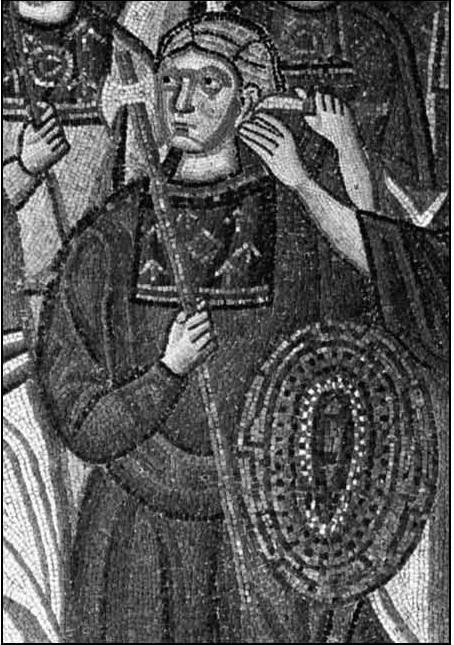
This blond soldier from the New Moni mosaic has a long ax with a double blade. He is wearing a dark blue tunic with golden arrows. On the shield are images of alternating concentric bands of red and blue, the center is dark green with a red emblem.
Warrior Guard Varangov - color mosaic of the XI.
Some graphic sources speak of the shield shield emblem of Varanga in the form of a black raven. Raven (the sacred bird of Odin) could be the emblem of the Varangian Guard. For example, it is known that most Varangian banners on historical This image adorned the homeland. So, the flag of Knut during the battle of Ashingdon in 1016 was a white silk panel with an embroidered image of a raven. The Anglo-Saxon Chronicle speaks of a raven on a trophy banner that was captured as early as 878. As the sagas testified, if the raven’s wings are folded, it means defeat, and spread wings promised victory. It had the image of a raven and the banner of Harald Hardrada.
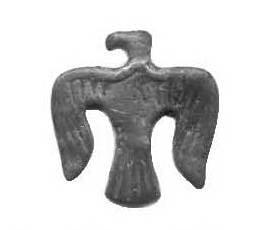
The eagle or raven is a detail of a jewel of a warang found in southern Bulgaria. X-XI centuries.
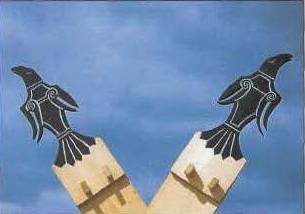
Odin's Crows - Varangi Emblem
Types of Varangian Guards XI-XIII centuries.
We know the following most important images of the warriors of Varangi.
On one thing - the image of a Varangian officer with a blue shield and in the likeness of a hood - we have already said.
Another Varang is shown on the Cretan fresco of the end of the XI century. The warrior is the owner of red hair, dressed in a tight dark red tunic, holds a battle ax in his hand.
Another fresco (betrayal of Christ; the church of St. John in Kilis, the beginning of the XIII century - now the territory of Turkey) shows us red-haired and red-bearded Varyags - also in dark red tunics and with long axes.
Images reflecting the capture of Constantinople by the Crusaders in 1204 allow for a detailed restoration of the appearance of the Varangi fighter. A mail armor reinforced with lamellar overlays is put on a scarlet shirt - a series of plates fastened with straps forms a continuous protection of the chest, abdomen and sides (a row above the lower edge of the chain mail). The plates are also protected by the neck and shoulders of the Varanga. On the head is a segmented spherical steel helmet with fields. The warrior is armed with an ax and a sword (the latter is attached to the left of the waist belt). The drop-shaped shield has a red color, a massive umbron and a metal edging. Hand protection below the elbow and legs missing. The outfit includes (except for the waist belt) the characteristic “Varangian sword belt” or the so-called “Varangian bra” (a kind of unloading in the form of a shoulder belt that distributes the weight of the chain mail) was worn with a “overlap” under the chest, and the weight of the armor was distributed better and the chain mail less crushed on shoulders).
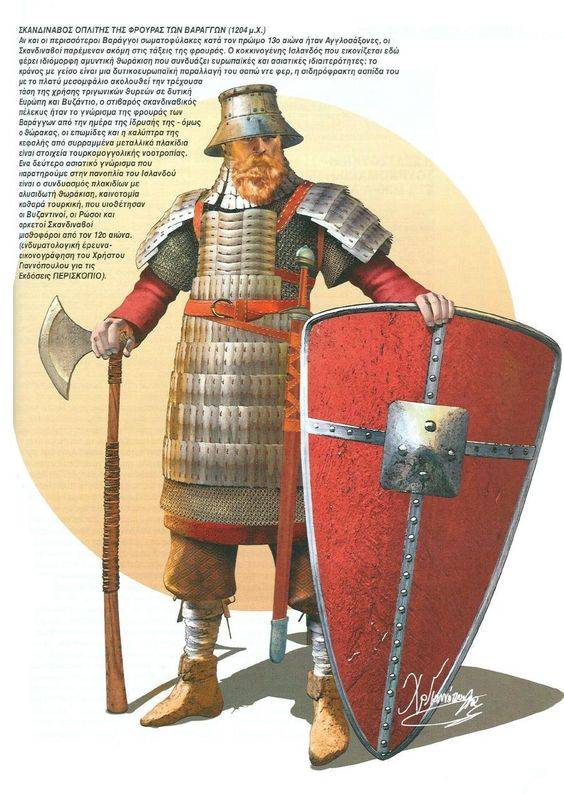
And modern reconstruction
A fragment of a fresco located in the Blachernae church (despot Epirus, 2-I half of the XIII century), shows us Constantine the Great, surrounded by his bodyguards. The latter (in fact, the varangians are depicted) are owners of long blond or red hair and beards, have shields, red and white cloaks, decorated with white stones at the edges, and chain mail armor. The fresco is a valuable source in relation to the history of Varanga during the century after the capture of Constantinople by the Crusaders and the Venetians.
Finally, the last known image of the Varangians is dated by the era of John V - John VI Kantakuzin (1341 - 1354) and shows the events of the 1351 Ecumenical Council - the presence of the emperor surrounded by his Guardians. The warang's ceremonial uniform at that moment included a blue dress with gold embroidery and a white hat in the shape of a boat with gold trim. We see a gold band with a bow, and the black and red scabbard of the sword is decorated with gold. By tradition, the sword is worn on the shoulder, as well as the ax (the latter from the Paleologo period is even on the seal of the Chief Interpreter Varangi). In general - clothing, characteristic of the XIV-XV centuries.
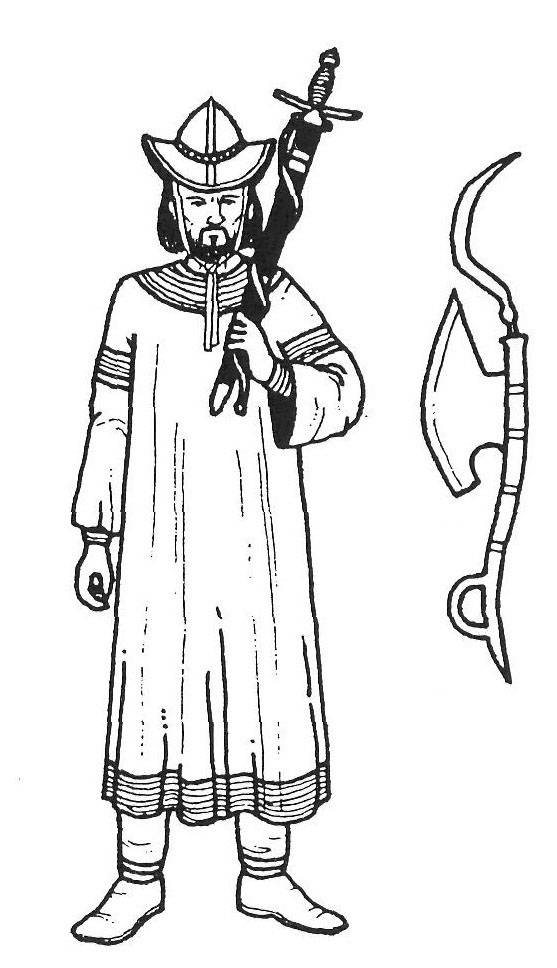
Varang with the image of the Ecumenical Council 1351
The commanders of the Varangian Guard often performed their duties (including in battle) while on horseback. That is why officer gear adapted to riding. In the wardrobe of the Varangian officer, we see oval cavalry shields, traditional pterigi, and feather ornaments on helmets. The officers wore blue cloaks decorated with yellow ivy leaves (a symbol of eternal life). Officer coats (for example, Bolli Bollason) could be decorated with embroidery in the form of geometric figures — perhaps their combination indicated the rank of commander. The command staff stood out gilded weapons and armor (sometimes, as in the case of the Pain Bollason, the gifts of the emperor).
In the fashion of the Varang were gold jewelry, symbolizing the high social status (hryvnia, chains and rings). Shields could also be decorated - even, as noted, with pearls.
Jewelry reflected both tastes of the owner, and a national identity. Thus, many Norwegian amulets carry the image of the hammer of the Scandinavian thunder god Thor. Christian symbols prevailed, of course, combined (especially in the early period of the history of Varanga) with pagan motifs. On their armor, the Varangas wore large body crosses.
Bracelets, twisted of silver and gold (a favorite gift from the eagles and princes to their warriors) are mostly decorated with images of animals, as well as the edges of many axes and swords found by archaeologists. The bracelets carried out and practical function - being made of precious metal, if necessary, they were cut, and cash was produced. Another very common ornament was a fibula, which was fastened a raincoat.
In the course of the Varang there were drinking horns - this specific dish and at the same time the attribute of the Varangian was widespread in northern Europe.
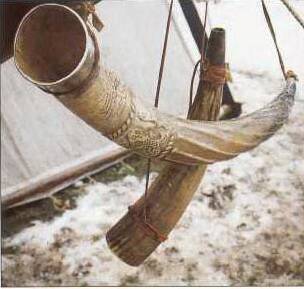
Drinking horns - item from the Varyag outfit
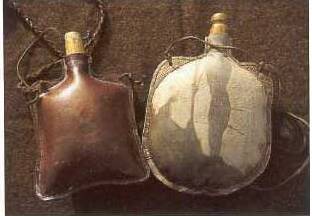
Varyag bottles - modern reconstruction
Varyags were distinguished by long blond and red hair and thick mustaches and beards (the Danes had darker hair). As an indispensable attribute of the North Guard Basil, Byzantine sources noted the presence of tattoos and high growth. Varangi paid great attention to their appearance. The mass of the comb, comb and scrapers found made it possible to trim the mustache and care for the hair. Mod-Varang had with him tweezers to remove excess hair and a tiny spoon to clean the ears.
As the successor of the old guards regiment, Eksuvitov Varanga inherited the scarlet dragon standard. The dragon was a tissue body, a bronze dragon head and something like a tail. The bronze head hollow inside was fastened on the top of the shaft, along with a silk serpentine sleeve. The air penetrated into the mouth of the dragon, passed through the body, leaving through the fluttering tail. Inside the dragon's body could be any instrument that emitted a characteristic whistle. Silk dragon's body was decorated with embroidery. Initially, the dragon standard was the banner of cavalry units of the Roman imperial army. Considering that Varanga was in essence a rapid reaction force, representing itself mobile (traveling) infantry (about this in the article about the Varangi Tactics), issuing her cavalry standard deeply symbolic.
In the IX - X centuries. Byzantine army was waiting for the unification of the system, form and names of military flags. In the same period, images of holy warriors actively penetrate into Byzantine iconography. Not an exception and Varang.
Known dating from the middle of the XII century. Such banners of Varanga are of the classical Byzantine form, they consist of the central part (square with a cross) and 3-x braids (blades), which allow identifying the military unit. There is an opinion that the number of braids meant the number of units in the unit. The colors are scarlet, blue (base), yellow (or light brown) and black. The banner is richly decorated with gold embroidery.
Banners were used both in field battles and during landing operations (as in the illustration below).
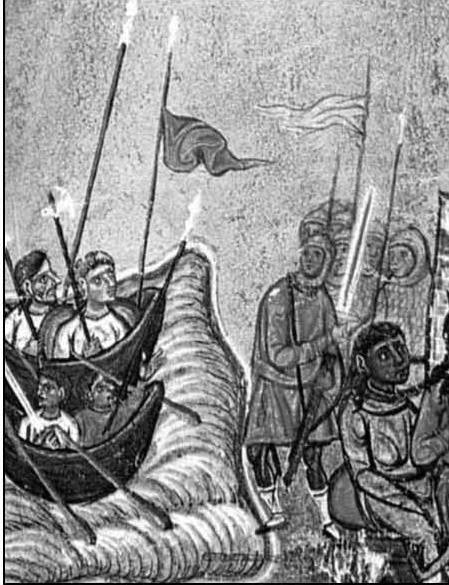
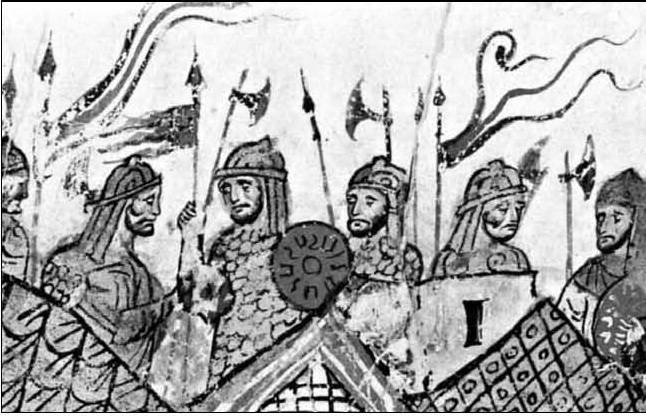
Banners of the Varangian Guard
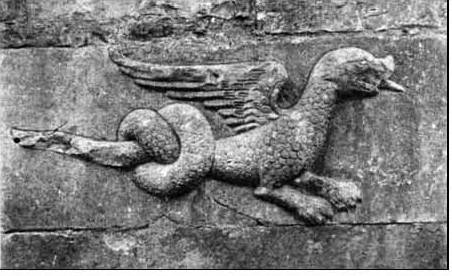
Dragon standard (image)
The Varanga marching equipment included: a hand mill, a cutter, a saw, a wicker basket, a hammer, 2 picks and 2 shovels. The tools used in the campaign of life and for the camp were transferred or transported in the train.
Leather belts had decorative buckles. Belt accessories were made, as a rule, from copper alloys. The belts were narrow - in width less than 2,5, see. In the course of the lizards, there were leather pouches and bags, purses. The latter were a circle cut out of the skin with holes at the edges (a cord was twitching in them). A large purse of a similar design could serve as a backpack during a hike. On the warrior's belt in the campaign, in addition to the pouch, there were usually scissors (to cut hair and a beard), flint and flint, tinder, a cup and a spoon.
The general trends in the development of the offensive and defensive armament complex of the Varangi fighter (beginning of the XI - middle of the XIII - beginning of the XV centuries) were as follows.
The chain haberk first turns into a chain mail (scaly, lamellar or lamellar shell worn over the chain mail) and then in a knightly type brigant armor. A segmented or all-steel dome-shaped helmet with chain mail barming turns into a spherical helmet with a chain mail mask, and then into helmets with a ballet and baszinet design. The round shield was replaced by a drop-shaped and oval shield, a kite shield and a triangular shield. A battle ax turns into an ax and then into a front hatchet, and an ordinary sword, the so-called. Frankish type replaces the two-handed German sword and the Byzantine types of swords and sabers. Clothing changed in the context of the development of a common fashion.
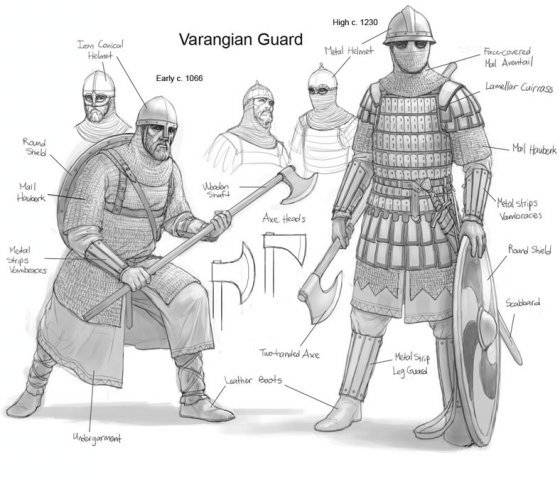
Trends in the development of weapons and equipment Varanga
Constantinople palace twists and turns 11. (in the background are the Varangian Guardsmen). Armed with axes to the height of a man and spears, they have a barmica on their helmets. Scarlet Fields
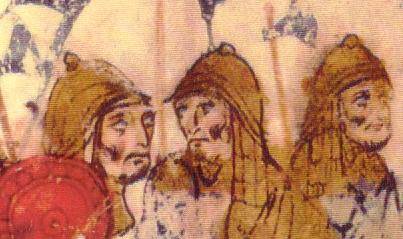
Fragment of the previous silt.
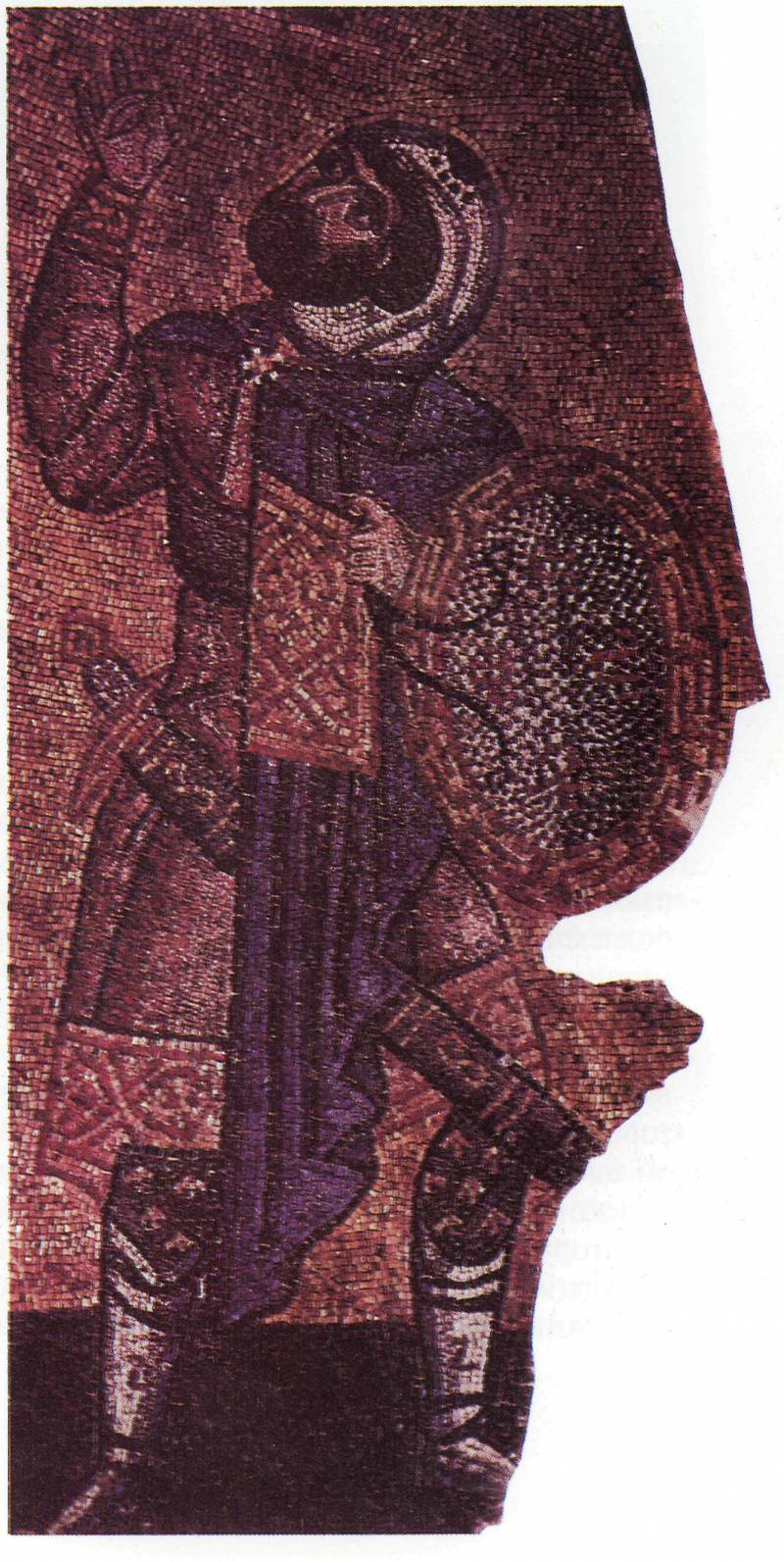
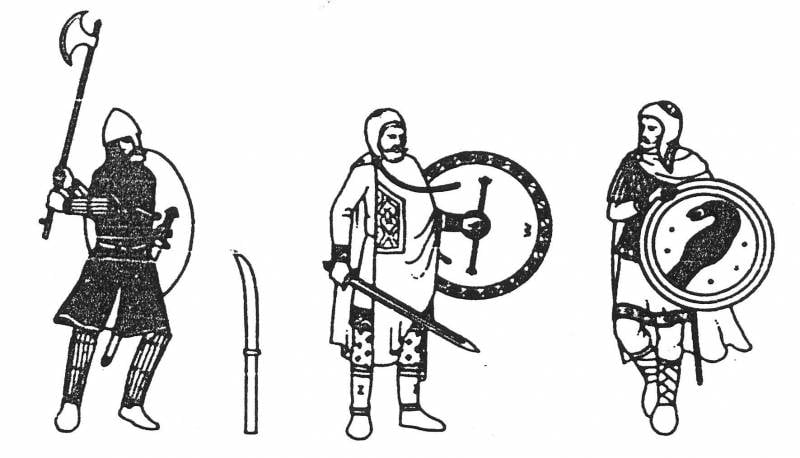
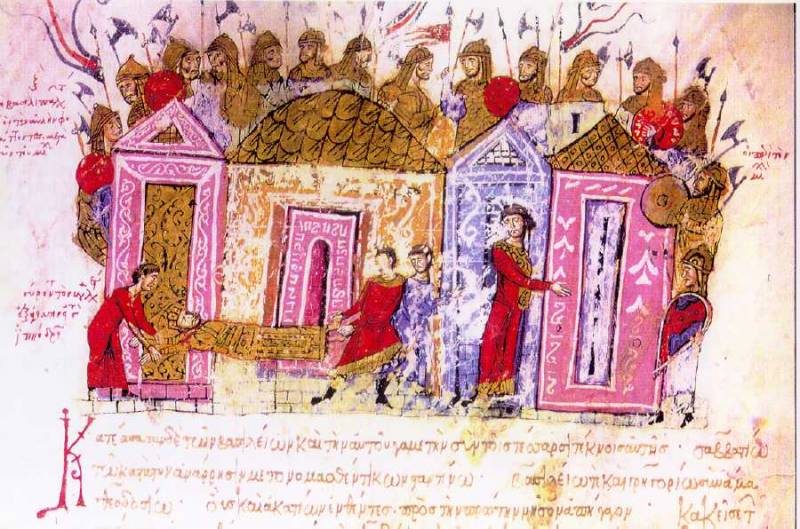
Information